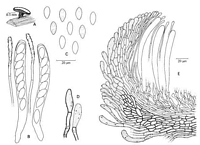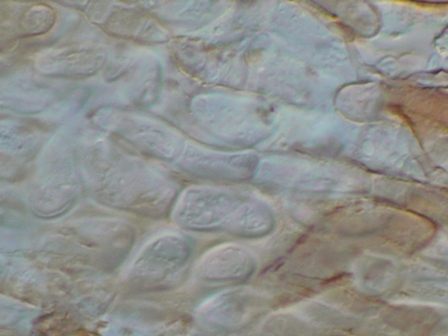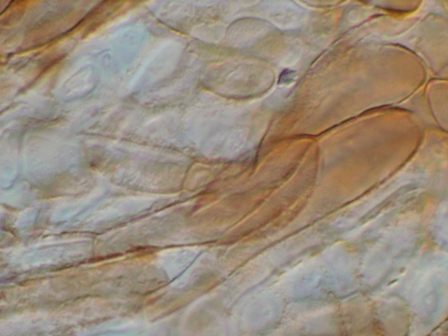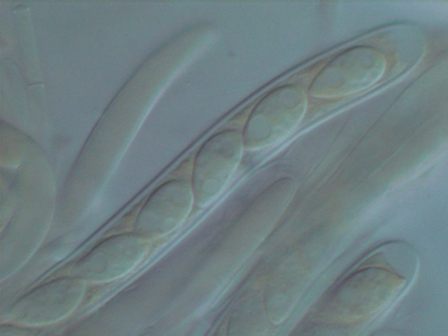|
 Lanzia ovispora Lanzia ovispora
BiostatusPresent in region - Indigenous. Endemic
Images (click to enlarge)
Caption: Figure 64. Lanzia ovispora, holotype. A. Apothecium. B. Asci and paraphyses. C.
Ascospores. D. Surface hyphae. E. Vertical section, upper receptacle. | 
Caption: excipulum with thick-walled cells
Owner: P.R. Johnston | 
Caption: encrusted hyphae on outside of receptacle, end cells fusoid
Owner: P.R. Johnston | 
Caption: ascospores
Owner: P.R. Johnston | |
Article: Spooner, B.M. (1987). Helotiales of Australasia: Geoglossaceae, Orbiliaceae, Sclerotiniaceae, Hyaloscyphaceae. Bibliotheca Mycologica 116: 711 p.
Description: STROMA substratal, causing conspicuous blackening of the leaf surface. APOTHECIA
scattered or gregarious, hypophyllous, situated on or near the midrib or main veins, erumpent,
stipitate. DISC 0-9-1.2 mm diam., plano-concave, bright yellow when fresh, drying deep
ochraceous to brick-red, smooth. RECEPTACLE cupulate to repand, darker reddish-brown
when dry, with a conspicuous yellowish-brown, tomentose-fibrillose surface. STIPE central,
stout, cylindric, shorter than disc diam., concolorous. ASCI 85-103 x 11-13 µm, 8-spored,
cylindric or cylindric-clavate, tapered below to a short, stout, rounded base, apex broadly
rounded or truncate, the pore not blueing in Melzer's reagent. ASCOSPORES
12.5-14.0 x 5.5-7.0, mean 13.2 (SD 0.5) x mean 6.1 (SD 0.3) µm, hyaline, broadly ellipso-fusoid to ovate fusoid, tapered distally, ends rounded or pointed, symmetrical or slightly
inequilateral, usually biguttulate, non-septate, obliquely uniseriate. PARAPHYSES filiform,
obtuse, remotely septate, 1.5-2.0 µm diam., enlarged towards the apex to about 4 µm diam.,
equalling or slightly exceeding the asci, somewhat agglutinated above by hyaline amorphous
matter. SUBHYMENIUM c. 30 µm thick at centre, narrowed to 15 µm towards the margin
at the base of the hymenium, composed of loosely interwoven hyaline hyphae and small
irregular cells 2-5 µm diam. MEDULLARY EXCIPULUM about 60 µm thick at the base of
the receptacle, narrowed towards the margin, composed of somewhat interwoven, largely
parallel hyphae, 4-5 µm diam., with hyaline or faintly pigmented walls. In the stipe, similar
vertically arranged, thin-walled hyphae occur. ECTAL EXCIPULUM composed of prismatic
cells mostly 10-15 x 5-7 µm in the receptacle, more elongated, 20-25(-30) µm in the
receptacle, more elongated, 20-25(-30) µm in the stipe, with thickened, somewhat refractive
walls, arranged in rows at a low angle to the surface, forming a layer 35-50 µm thick,
narrowed to the margin. Ectal cells hyaline or very pale brown, giving rise at the surface to
clavate, hair-like elements up to 60 µm long, 6-10 µm diam., at the apex, with brown or
yellow-brown walls. Pigmentation uniform, particularly on cells towards the margin of the
receptacle, or deposited as irregular granules. Ectal cells at the margin more elongated, brown
and thin walled, marginal tissue 30-35 µm thick
Habitat: On rotten leaves of Elaeocarpus hookerianus. New
Zealand, known only from the type locality.
Notes: DERIVATION: From Latin ovi-, egg, and spores, referring to the form of the ascospores.
Lanzia ovispora shows some similarity to L. berggrenii and the type collection had, in fact,
been referred to L. metrosideri, treated in the present account as a variety of L. berggrenii, in
the herbarium. Both are foliicolous species with a fibrillose surface meshwork on the
receptacle. Lanzia ovispora differs from L. berggrenii in colour and in ascospore characters.
Stromatic development is variable, though conspicuous in patches, and it undoubtedly belongs
in the Sclerotiniaceae. The ectal excipulum of both the stipe and receptacle is composed of
prismatic cells with somewhat thickened and refractive walls, though towards the margin the
cells become thin-walled. I do not regard this as a gelatinized excipulum as exhibited by
species of Poculum, and, therefore, refer this species to Lanzia. The fibrillose surface,
composed of brown, granularly-roughened hyphae is also characteristic of the genus.
Lanzia griseliniae has similarly deep-coloured, foliicolous apothecia but lacks the
fibrillose meshwork on the receptacle and differs otherwise from L. ovispora in having
narrower spores and asci. Lanzia albo-atra (Hennings) Dumont is probably also closely
related. It has a fibrillose covering layer to the receptacle and broad ascospores, but differs
markedly in colour.
|